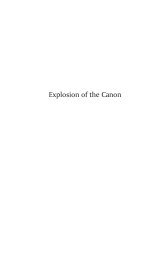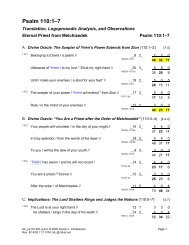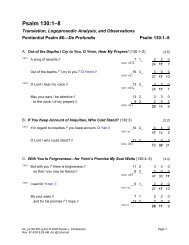Reading Genesis 1-2 in Hebrew - Bibal.Net
Reading Genesis 1-2 in Hebrew - Bibal.Net
Reading Genesis 1-2 in Hebrew - Bibal.Net
You also want an ePaper? Increase the reach of your titles
YUMPU automatically turns print PDFs into web optimized ePapers that Google loves.
<strong>Read<strong>in</strong>g</strong> <strong>Genesis</strong> 1–2 <strong>in</strong> <strong>Hebrew</strong><br />
�����‘��ƒ���„���‘������ô���������‡<br />
•œ•���1:4� �������������û������„������û������������������•œ•�����<br />
����‘��ƒ���„���‘������ô���������‡<br />
•œ•��—transliteration: way-yaµr' 'È-lO-hÓµm 'et-hA-'Ùµr KÓ-XÙµb, “and<br />
Elohim saw the light that it was good.” The verb '⁄rC¬yaw is the Qal imperfect 3 rd sg. masc. from the<br />
root h'r (“see”), with £yih◊lÈ' (“Elohim”) as subject. The def<strong>in</strong>ite direct object marker te' is<br />
connected by maqqEp to the fem. noun rÙ' (“light”). In 1:1 tE' appears <strong>in</strong> an accented closed<br />
syllable; here the syllable is un-accented, because it is jo<strong>in</strong>ed by maqqEp to the follow<strong>in</strong>g word,<br />
hence short e (e–) appears <strong>in</strong> the unaccented syllableñte'. The conjunction y–ik (“that”) is<br />
connected by maqqEp to the predicate adjective bÙX (“good”).<br />
������������û������„������û������������������•œ•�—transliteration:<br />
way-yabDEµl 'È-lO-hÓµm B µn hA-'Ùµr<br />
˚b µn ha-xOµ-Hek, “and Elohim divided between the light and between the darkness.” The verb is<br />
Hiphil imperfect 3 rd sg. masc. from the root ldb (“be divided, separate”) with £yih◊lÈ'(“Elohim”)<br />
as subject. The letter n at the end of a word is written §, not n; and the letter k is written , not k.<br />
When the space between two dist<strong>in</strong>ct objects is <strong>in</strong>dicated, this is commonly done by repeat<strong>in</strong>g<br />
the preposition §yEb (“between”), which is the construct state of §«y–ab (“<strong>in</strong>terval, space between”).<br />
The two nouns rÙ'Ah (“the light”) and eHxµah (“the darkness”) both have the def<strong>in</strong>ite article and<br />
both beg<strong>in</strong> with a guttural. Before the labial b, the word and is written ˚ (so also with m and p;<br />
i.e., <strong>in</strong> the three so-called B˚mep labial letters). Notice the compensatory lengthen<strong>in</strong>g of the<br />
vowel with the def<strong>in</strong>ite article <strong>in</strong> the noun rÙ'Ah (“light”) whereas the x <strong>in</strong> the noun eHxµah is<br />
treated as though it were doubled (virtual doubl<strong>in</strong>g).<br />
Occurrences of Spirants and Stops of b, k, p and t <strong>in</strong> <strong>Genesis</strong> 1:1–4<br />
tyiH'Er–⁄b –b (B, not b) follows noth<strong>in</strong>g; t (t) follows Ó<br />
'Ar–Ab –b (B, not b) follows t of the preced<strong>in</strong>g word<br />
tE' t (t, not T) follows the vowel sound E<br />
hAt¯yAh t (t, not T) follows the vowel sound ¸<br />
˚h»bAw ˚h»t t (T) follows ‰ of previous word; b (b) follows A<br />
y≈nL¯p-lav Lp (P) follows the consonant l<br />
£Ùh¯t t (t) follows the vowel-sound<br />
tep¥exar⁄m p (p not P) follows e; t (t) follows e<br />
bÙX-y–ik –k (K not k) follows r; b (b) follow Ù<br />
l–Ed¯bC¬y¬w b (b) follows a; –d (D) follows consonant b<br />
§y–Eb –b (B) follows the preced<strong>in</strong>g consonant £<br />
eH¥x §yEb˚ b (b) follows the vowel ˚; (k) follows the vowel e<br />
© 2005 BIBAL Corporation, All Rights Reserved Version 1.0<br />
4





